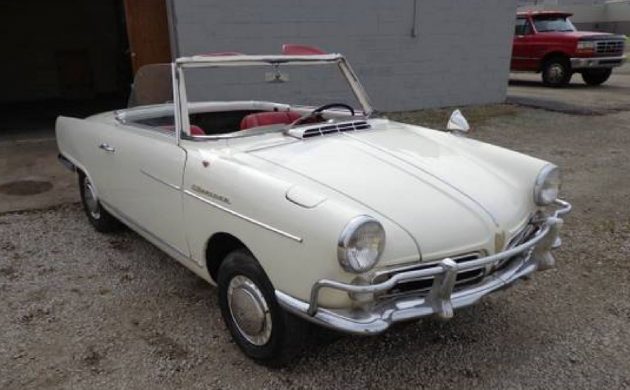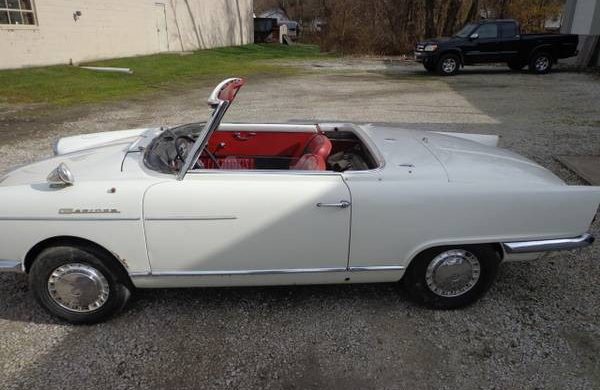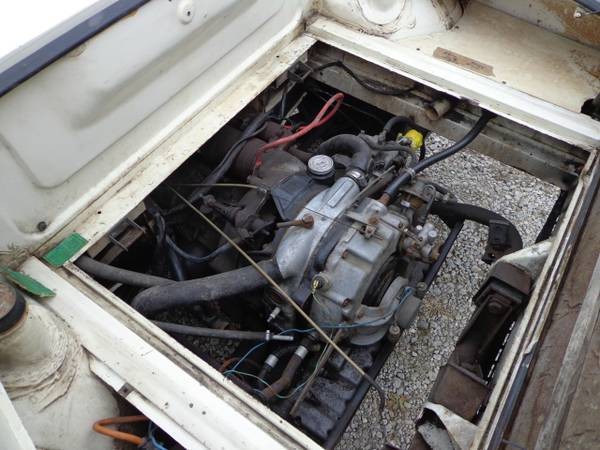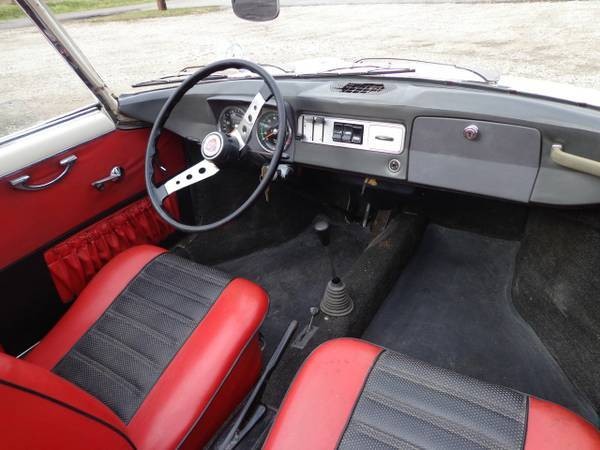UPDATE 12/10/2021: It seems that the owner of this 1965 NSU Spyder had no success in finding a buyer for this rare classic last time, so he’s taking another shot at it. Maybe he’s hoping that with the festive season fast approaching, someone will want to park it under their tree! It seems that little has changed since we last saw this classic, although, in addition to considering reasonable offers, it appears that he may consider a trade for a vintage British classic. The NSU remains located in Lyons, Illinois, and is listed for sale here on Craigslist. I have to say a big thank you to Barn Finder Jeff C for spotting this rare gem for us.
One of the joys of writing for Barn Finds is seeing interesting, rare, and genuinely quirky classics arrive on our desks. Those words would seem appropriate when describing our feature car. It is a 1965 NSU Spider, and the company produced it in strictly limited numbers. It may not appear any more radical than any other small convertible from the 1960s, but it featured an engine that was unlike anything offered in any other production car at the time. How many remain in existence today is unclear, but this one provides the chance for someone to own a vehicle that is guaranteed to attract attention at a show or a Cars & Coffee. If you find yourself magnetically drawn to this NSU, you will find it located in Lyons, Illinois, and listed for sale here on Craigslist. The owner doesn’t specify an asking price but expresses a willingness to consider reasonable offers. I have to say a huge thank you to Barn Finder KENNETH A for referring one of the most interesting cars to come out of Germany.
NSU based the Spider on its Sport Prinz Coupe, with both cars emerging from the design studios of Bertone. Its overall styling is pretty typical of small convertibles of the era, although the extended rear deck indicates that it is anything but conventional. It wears what appears to be its original White paint, which is one of only two colors the company offered on the Spider. If this shade was too conservative, the alternative was a particularly vibrant shade of Red. The paint condition shows promise, so it would be interesting to see how it responded to a careful polish. The body appears to be in good order, with no significant dings, dents, or other problems. I can’t spot any evidence of rust, and the owner doesn’t mention any issues in that respect. NSU was renowned for build quality, so this classic may be rust-free. The trim looks respectable for a survivor, and it appears that the original wheel trims have survived without any significant damage. The original soft-top is beyond help, and sourcing a replacement could present the buyer with a challenge. If they have no success locally, they may need to hunt online to locate a German supplier. The door glass is in good order, but the windshield is gone. Like the top, the buyer may need to perform some online searching to secure a replacement. That represents two of the challenges with this Spider, but we’ve still got one to go.
During the 1960s, NSU produced a series of small cars that featured a rear-engine configuration. These included the Prinz, the Sport Prinz Coupe, and the Spider. While the first two vehicles were powered by air-cooled OHV engines of either two or four cylinders, the Spider was radically different. It represented the first western offering that featured the innovative Wankel rotary motor. I have only driven one car equipped with this type of engine, which was a 12A-powered Mazda. The experience was almost eerie because it felt like the motor produced no real torque, but the engine revs wound to stratospheric levels incredibly quickly. It was also the smoothest engine that I have ever experienced in any motor vehicle in my life. For the Spider, NSU produced a single-rotor engine with a nominal capacity of 498cc. This is rear-mounted and sent its 64hp to the rear wheels via a four-speed manual transaxle. The power figure may not sound impressive, but it was enough to send the Spider galloping through the ¼ mile in 19.2 seconds. If the driver was prepared to keep the foot to the floor, that Wankel would run out of breath at 95mph. I previously mentioned a further challenge with this classic, and we’ve reached the point where we need to consider it. The motor appears to be virtually complete, but it doesn’t currently run. The only items that I can’t see are the generator and exhaust, so it would be worth asking the owner questions on that front. It turns freely, but it is unclear whether there are any internal issues that the buyer may need to address. Rotor tip seals could present problems in these engines, although it seems that those in the Spider were less of an issue than in the later Ro 80. It would be worth finding a Wankel specialist to inspect the unit before hitting the key because the rarity of these little cars may make it difficult to locate replacement engine components for those that may be damaged if care isn’t exercised.
One aspect of the Spider that will require little attention is the interior upholstery. It features its original red and black vinyl trim that is in excellent condition. There is some minor wear on the carpet, but the biggest issue is the hole in the top of the dash where the speaker grille has collapsed. This could be a significant problem because finding a replacement could be a battle. Unfortunately, the dash in the Sport Prinz is different, so if the buyer has no success sourcing a replacement, they may need to approach a restoration specialist to see if the existing dash can be salvaged. What I find interesting is how sparse this interior is. The Spider was an expensive car for its type and size, and apart from a heater, a sporty wheel, and some VDO gauges to monitor the health of that little rotary, there are no further creature comforts.
NSU had a history of pushing the boundaries, and while it produced some innovative cars, this approach eventually forced the brand over the financial brink. The final straw came due to the myriad of engine problems that beset its wonderful Ro 80 model. A lifeline appeared when the Volkswagen group purchased the company, but it marked the end of an era. While NSU produced 2,375 examples of the Spider during its four-year production run, it is believed that only around 215 cars found their way onto North American shores. How many survive today would be no more than an educated guess, but their rarity means that they don’t often hit the market. Given its relatively complete state and overall physical condition, I would expect that someone will need to find at least $15,000 if they wish to become its next proud owner. Some people may consider that to be a lot of money for a non-running project car of this type, but the last couple of spotless examples that have gone to market recently have topped $35,000. With those thoughts in mind, is this a classic that you might be tempted to pursue further?








Adam, if my memory is correct, the Wankel Spider — like the piston-powered Prinz — used a “Dyna-start,” which as the name suggests combines the functions of a starter and generator. I think I see it in the engine photo.
These are quite fun to drive — as is the Ro80 — but take some getting used to; as you mentioned, they seem to have no torque at all! Get the revs up and wait for things to happen…. And yes, the engines are wonderfully smooth.
The cosmetic issues of dash cover and top wouldn’t worry me, as they are common to many old cars and there are shops that could conceivably repair/replace both; finding spares for the engine would be an issue, I think.
I had a Suzuki RE5 roatry engine motorcycle back in the late 70s, and just like the motor on this Spider, it had no torque to speak of. But it could go quite fast if you were patient and the higher it “revved” the smoother it got.
I called on another one for sale in Montana a while back. Red and in similar condition but unfortunately the engine was missing. These early Wankel’s were very unreliable and I believe it’s one of the reasons for the demise of the company. I would love to find a Ro80 as well.
I was told the NSU rotaries were unreliable from the beginning and, despite lots of development work, remained so. Rotaries only came right when Mazda produced them, and even theirs were problematic, especially in their early iterations. Ask me, as an RX-3 owner, I know….
The Ro80 I drove in Germany had the “automatic” transmission, closely related to the VW Automatic Stick Shift and Porsche Sportomatic. I was not amused. One dared not touch the shift knob unless actually shifting, lest the microswitch therein disengage the clutch. Embarrassing; lots of revs and no motion!
I know it will make some people cringe but I always thought a Ro80 with a 13b transplant would be the way to go. Yes I would also get rid of the auto-stick. Cars were definitely ahead of their time.
Rotaries were still unreliable even in the RX8, as those motors couldn’t go 100k without needing seal replacement.
My experience with rotary engines is that they are plenty reliable – won’t leave you stranded – but the apex seal is a consumable and just part of the price you pay.
I swapped a 13b Mazda engine into an Ro80 many years ago. It was not that difficult as a Canadian offered instructions and drawings for the few special parts needed. The car was quite nice to drive-other than the automatic stick shift.
Tales of unreliability are mostly exaggerated in my opinion and experience.
I knew a guy who tried to race one in SCCA against bug eye sprites. Got an almost new one cheap. Took off the exhaust. Would not run. Added a used motorcycle exhaust. Ran as well as new, but louder, like an eary fart can rice racer. Zippo torque. I later owned a 12A RX7. No comaprison, The Felix’s Wankel wondercar was slooow.
Time to dispel myth: NSU was actually renown for its build quality. By the time this car was built, they had pioneered and patented a rust-proofing process no one else would match for almost 20 years. As to early NSU engines, the Spider’s brothers: Prinz, Sport Prinz and Prinz 4L, were all powered by NSU’s revolutionary air cooled 2-cyl which was light years beyond any other micro-car technology-wise based on the engine of the Supermax motorcycle (fun fact: NSU was once the largest motorcycle manufacturer in the world). Their first 4 cylinder would come in the Typ 110 which evolved into the legendary TT (for which the Audi of the same name honors). Finally on to NSU’s rotaries: Felix Wankel actually worked for NSU.
The KKM series engine in this car was actually fairly reliable and isn’t prone to filters. The KKR dual rotor in the Ro80 had early teething issues with the rotor tip seals that often required warranty replaced less than 20K miles in. These problems were fixed however 2 years into production and later Ro80s are well known for reliability.
NSU’s financial difficulties were not related to the problems with the Ro80, but were largely due to them spending literally millions of dollars in the early 60s developing the rotary, the Ro80 problems were just the nail in the coffin which forced the sale to Audi under Volkswagen Group. The last real NSUs would be the VW K70 and original Audi 100. Had VW/Audi not purchased NSU, there would have been a very different history. The purchase gave VW access to modern rust proofing as well as the tech to build water cooled engines in house.
NSU is one of those car companies that was super important to automotive history, but like French Panhard (pan-are), they are sadly largely unknown now
*failures, not filters (thanks Apple autocorrect)!
Oh, and lest not forget, the famous Claus Luthe got his start working at NSU designing the Ro80 before moving on to BMW and creating his seminal work: the E30 3-Series
Fascinating history – thank you for sharing your knowledge of this impressive, ground-breaking company.
Brillianter Beitrag!!
True story. NSU motorcycles were legendary. They dominated international racing in the 250cc class for several years. The Consul was a beauty with enough torque to pull out tree stumps. The Supermax was technically superior to most others and was the basis on which Honda Motors were born. As far as cars go, they had a working relationship with Fiat in the 1930´s and built the cutest little Fiat-based roadster called ¨Weinberg¨, if memory serves. The demise of the motorcycle industry hit them very hard. The ill advised attempts at curing the Wankel´s problems robbed them of their reserves which was the kiss of death when things got economically tight. The NSU Pribnz 1 liter was a smash success, especially in Italy where it won numerous local club races.
A fun trivia tidbit – NSU’s first rotary product was a device with very long handle bars, intended to tow a water skier! Their first use of the technology was as a compressor (supercharger) on their world land speed record bikes, full streamliners that were the first to break BMWs’ 1938 record (the last on a conventional wheel base). They also ran a 50cc motor in the streamliner with a rotary compressor.
My dad had a NSU Prinz, he luved that car.
I heard NSU became Audi well B4 the vedub scoop-up, at any rate there’s a reason the wankel is no longer seen. Just like the buick alu bent8 improvement/production by the Brits; Japan really went to town on this one (became ‘rotary’). I knew usa, france (& again the Brits) went to Italy for design styling but never the german & this is clearly shown in this lill cutie. I C the alfa & others (rear deck, transom, 1/4s, nose doors forward, etc) here. Thnx for the description of the piloting’n sound. I’d DD it if having a hrd top along w/the vert (live in the Noreast).
Plenty of great comments on NSU here, so I won’t bother to repeat the history lessons! I was one of the guys who bought out Allied Light Cars in Washington DC after NSU stopped importing the cars. Allied was a direct importer for NSU, and one of the cars in the leftover inventory was a red with black hardtop Spyder that was the test car for the Road & Track magazine article. It was one of 2 Spyders Allied Light Cars had, along with another 20 or so of the 4 cylinder variants, including a couple of the potent 1200TT and TTS cars.
Because most of the body and trim parts are off the Sport Prinz coupe, pieces are available. Exceptions are the air intake emblem on the deck lid, and the taillight assemblies have always been hard to find because they didn’t last. Whoever buys this should go ahead and arrange for a NSO rotary engine expert to tackle the overhaul, because if the car has more than 10,000 miles, it will need overhaul. These cars often have beautiful interiors as long as the car was garaged. They simply didn’t have engines that lasted long enough for the interior to get worn out! I think the windshield is the same as the Sport Prinz, so it should be possible to source one in Europe. Same with the dash pad.
Let’s not forget Creams hit song N.S.U, which stands for Non-Specific Urethritis, a type of venereal disease Eric Clapton had during the recording of that song,,,what, too much info?
The only NSU car I knew of was a guy down the block from my parents had a Prinz coupe race car with a rotary, I think, that claimed the front end began to lift at anything over 100 mph on Road Americas front straight. It was a loud thing, and everybody in the neighborhood knew when ol’ John was a fixin’ to go racing.
Thanks for the article on NSU. I really enjoyed it. I have a 1967 NSUTTS that I am trying to restore a 1967 NSU TTS. As you know parts are the biggest problem locating. I would appreciate any information anybody can give me on locating parts in the US or even overseas. I’ve ordered parts from Germany before and it was a disaster because of the language barrier. I ended up with the parts I don’t need or want but it cost more to return them then to just keep them. Windshields are the hardest to come bye as I can’t get anybody from Germany to ship one because of breakage. Appreciate any info anybody can give me. Thanks, Darrell McLean, 425 343 5724
Darrell,
It’s been close to 40 years since I did much with the NSU 1000, 1100, 1200, TT and TTS cars. By far you have the best of the lot. I had new windshields in stock here in Maryland until 5 May 1995, that’s when lightning hit my building and I lost everything in my parts department.
The first thing I would suggest is you join the NSU club in Germany. You can probably pay by PayPal. Most members do speak/read English. With today’s free computer translation systems, l cannot see language as being that much of a problem, especially if you make contacts by email.
You need to buy a parts manual. when ordering parts, take a photo of the exploded parts view, circle the part needed, that way it will lessen the chance of the part you get being wrong. Also make sure you provide the VIN for the car, Like many foreign car companies, they made changes during a model run, so to be sure you get the right part, provide the VIN.
One important thing to know: On the later TT and TTS cars there is a metal cover over the starter motor, this is to direct fuel away from the starter should the carb above it leak. Many people discarded this shield when removing either the starter or the carb above it. And those carbs DO leak! I’ve seen multiple cars that caught fire because the carb leaked and the shield was missing.
And for those not familiar with the NSU TT and TTS cars, these were about as close to factory racing cars as you could get in 1960s inexpensive European auto racing. They were available at NSU dealers everywhere, including North America.
Bill, thank you for the info. Are used to race in their shoes and what they called foreign stock back in the 60s and 70s. The car was such a great car and very reliable I decided to buy one for street use. I drove this car around town for probably 8 to 10 years. It’s been sitting for about 40 years and I decided I wanted to restore it. I am at the age now I’m having a tough time thinking about it and I am actually looking for someone that does that kind of work of restoration. If you or anyone else can steer me someplace I would really appreciate it. Thanks, Daryl
Darrell,
Forgot to mention; To find a windshield, try looking at glass companies in north America that specialize in European glass. They probably get bulk windshield shipments on a regular basis. It might cost a little bit more, but if it gets broken, you order another.
If you are ordering a windshield in Europe, you MUST have it shipped in a solid [no cardboard sides] wood container, the glass standing on edge [not flat]. It’s more expensive, but packed and braced properly, the crate will be heavy enough that it will require a forklift to move around [it’s not going to be tossed around by humans]. Glass of all types is very strong when shipped on it’s edge. Laid flat, it’s gonna crack.
NSU also sold well in England, you might have better ordering experiences because they speak a similar language to us. Try the NSU owner’s club; http://www.nsuoc.co.uk
And when I have needed a rare piece of glass for a customer’s car we were restoring, I generally ordered 2 pieces, and kept 1 in the original shipping crate, the crate given to the car’s owner, clearly marked as to what car the glass was intended for. That’s called Murphy insurance. As long as you have an extra, you won’t need it.
If you plan on driving your TTS in competition, I suggest you go ahead and order 2 windshields, the shipping cost will be almost the same.
The wanker engine was a dead end for a reason, they suck in all aspects, only one to really use them was mazda and they got rid of them
Now here’s a car that could really benefit from a Hayabusa transplant. Throw that Wankel lump out along with what passes for a transmission, and put the Suzuki motor in its place. It’ll make the car much better than it was dreamt of being.
it truely baffles me how little the morons that are on this site actually know about automobiles and vintage cars. you leave the motor alone. if you don’t like it, don’t buy it.
Can you imagine the power to weight ratio of a LS or hell crate swapped limosette? OK I’m a colonial but sometimes unrefined is OH SO MUCH FUN! crickets
Rotaries are fab. I worked at a Mazda garage and got to drive an early RX-7 with a Janspeed exhaust that had been to a dyno for setup work. I rode stroker bikes as my daily transport back then, so was used to having no torque.